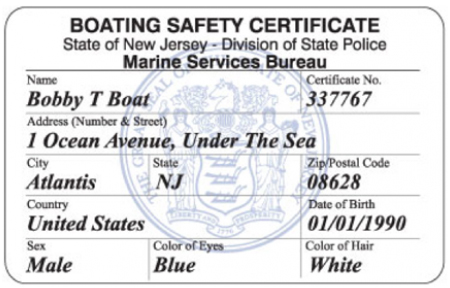Marine Services Bureau
Boating Safety Initiative
“The speed at which a power vessel moves through the water maintaining minimum headway and produces the minimum wake possible”
New Jersey regulations define "slow speed/no wake" as the speed at which a vessel moves through the water and is able to maintain minimum headway in relation to the vessel or structure being passed and producing the minimum wake possible.
New Jersey laws require that the speed of every vessel be regulated so as to not cause danger or injury to persons or property, either directly or by the effect of the vessels wake. In addition, New Jersey regulations require that all vessels must be slowed to “slow speed/no wake” when passing:
- A marina, pier, dock, wharf or abutment at a distance of 200 feet or less;
- Work barges, platforms or floats while actually engaged in work related activity;
- Through bridge openings of 400 feet or less;
- Through lagoons, canals and confined areas of less than 200 feet in width;
- Vessels not under command;
- Emergency vessels displaying sequential flashing or rotating blue lights; or
- Vessels engaged in activities recognized by the Coast Guard displaying rotating or sequential flashing red and yellow lights.
The speed of power vessels shall at all times be regulated so as to avoid danger or injury to all manner of craft whether floating, moored, anchored or underway, or to piers, wharfs, bulkheads, draw spans or other water-front construction, either directly or by the effect of the wash or wave raised by such power vessel through its speed or otherwise.
13:82-1.7 Speed(a) No person shall operate a vessel in a manner where the speed and/or wake of the vessel may cause danger or injury to life or limb or damage to property.
(b) All vessels shall reduce speed to slow speed/no wake when passing:
- Any marina, pier, dock, wharf or abutment at a distance of 200 feet or less, except on Lake Hopatcong, in accordance with N.J.A.C. 13:82-3.11;
- Work barges, platforms or floats while actually engaged in work related activity;
- Through bridge openings of 400 feet or less;
- Through lagoons, canals and confined areas of less than 200 feet in width;
- Vessels not under command;
- Emergency vessels displaying sequential flashing or rotating blue lights; or
- Vessels engaged in activities recognized by the Coast Guard displaying rotating or sequential flashing red and yellow lights.
(c) "Slow speed/No wake" as used in this section means the speed at which a vessel moves through the water and is able to maintain minimum headway in relation to the vessel or structure being passed and producing the minimum wake possible.
(d) State Police, on the recommendation of the Commission or on its own initiative, may designate a specific area not included in (b)1 through 6 above as a temporary slow speed/no wake area based on congestion, visibility, safety, or other good cause. All vessels moving through these areas shall reduce their speed to slow speed/no wake within a 200-foot radius of the sign or buoy, in addition to any restriction under (b) above.
(e) No person shall place, anchor, or construct any buoy that states or implies that an area is a "Slow Speed/No Wake" area except as provided in (a) through (d) above. The State Police may remove or have removed any such unauthorized buoy.
You can report boating violations to the nearest New Jersey State Police, Marine Services Bureau station (see the “Locate/Contact A Station” section of the web site for station locations and contact information). You will be asked to provide as much information about the vessel and its occupants as is possible, including, to the best of your ability, a description of the vessel, the location and direction of travel, the vessel registration number, a description of the operator and the number of passengers on board, and any other information that could be used to identify the vessel and/or the vessel operator.
If a boating violation is not witnessed by a police officer, a complaint cannot be signed by an officer. In that case, you may file a complaint against the vessel operator. This will require that you contact the municipal court in the jurisdiction in which the violation occurred, and furnish the information necessary to identify the vessel and/or operator. Please remember that if you choose to file a complaint, you will likely be required to testify in court.




